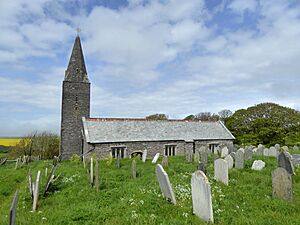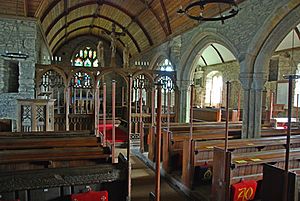St Germanus' Church, Rame facts for kids
Quick facts for kids St Germanus' Church |
|
|---|---|

St Germanus' Church
|
|
| 50°19′16″N 4°12′43″W / 50.3212°N 4.2120°W | |
| Location | Rame, Cornwall, England |
| Denomination | Church of England |
| History | |
| Status | Active |
| Consecrated | 1259 |
St Germanus' Church is a historic Church of England church located in Rame, Cornwall, England. Much of this beautiful church was built a very long time ago, in the 13th and 15th centuries. It has been recognized as a Grade I listed building since 1960, meaning it's a very important historical site.
The church is named after St. Germanus. He was a bishop of Auxerre from an ancient region called Gaul (which is now France). People believe he landed near Rame around the year 429. He came to Britain to help stop a religious idea called Pelagianism, which was seen as a mistake by the church.
Contents
A Look Back: The Church's History
People think there has been a church on this spot since the time of the Normans. This idea comes from finding a special carved stone called a tympanum. This stone, which is now in the west wall of the south aisle, dates back to the Norman period.
The current church was officially opened and dedicated to St. Germanus on October 15, 1259. This special event was led by Walter Branscombe, who was the Bishop of Exeter at the time. Parts of the church that are still standing from this early period include the top part of the tower and its spire, along with the north wall of the chancel and the north transept.
Later, a south transept and a tower arch were added. The church was dedicated again in 1321. In the 15th century, the church became even bigger. The south transept was replaced with a south aisle and a south arcade, built in the Perpendicular style. The church had some repairs in 1848. Also, a smaller church, St Andrew's, was opened in 1878 to serve the nearby village of Cawsand.
Big Changes: The 1883–1885 Restoration
Another major restoration of the church happened between 1883 and 1885. This work was paid for entirely by Kenelm William Edward Edgcumbe, who was the 6th Earl of Mount Edgcumbe. The project was designed and managed by Messrs. Hine and Odgers from Plymouth. It was during this restoration that the old Norman tympanum stone was found!
Workers repaired the outside walls of the church. Even though much of the wood was damaged, the special curved ceiling, called a wagon roof, in the south aisle was saved. However, many of the other wooden roofs in the church were rotten and had to be replaced.
New oak and fir wood stalls were added to the chancel, which is the area around the altar. New pews, which are the long benches for people to sit on, were also added to other parts of the church. Interestingly, pieces of 15th-century oak seating were found under the church's old square pews. These pieces were put back together to create five new seats in the south aisle. Old stone slabs with names carved on them were relaid in the walkways. New tiles were also put on the floors of the chancel and the sacrarium, which is the sacred area near the altar.
A new oak pulpit, where sermons are given, was made by Mr. Harley of Plymouth. All the church's windows, except for the large east window, were given new glass by Messrs. Fouracre and Watson from Stonehouse. The holy table, made of oak, and the churchyard lychgate, which is a covered gate at the entrance to the churchyard, were gifts from Rev. R. Ley. The church officially reopened on April 22, 1885. A large crowd attended the service, and a sermon was given by George Wilkinson, the Bishop of Truro.
What the Church Looks Like
St Germanus' Church is built from rough slate rubble, with special granite stones used for details. The slate roofs were added in the 19th century. The church has several main parts: a nave (the main area where people sit), a chancel (the area near the altar), a west tower, a south aisle and a south chapel, a north porch, a north transept, and a north vestry.
Inside, you can find some interesting old features. There's an octagonal (eight-sided) font from the 14th century, which is used for baptisms. Some of the pews date back to the late 15th century. There's also an organ loft from the late 19th century and a screen made around 1930 by Herbert Read of Exeter. You can also see monuments dedicated to various people, including Mary Ashton (1664), John Batterby (1672), Roger Ashton (1677), and Stephen Edwards (1797). One unique thing about this church is that it has no electricity, gas, or water! Services are lit by candlelight, which must create a very special atmosphere.
Churchyard and Historic Headstones
The churchyard surrounding St Germanus' Church is also very old and important. In 1987, several of the headstones in the churchyard were given Grade II listed status. This means they are protected because of their historical importance.
Here are some of the people whose headstones are listed:
- Thomas Wickell, 1749
- Richard Wight, 1750
- Rebecca Gray, 1758
- Susanna Davies, 1768
- John Williams, 1779
- Ann Pyke, 1781
- Jennyfer Verco, 1781
- James Gordon, 1782
- Elizabeth Verco (and other members of the family), 1787
- Jane Jago, 1793
- John Austen (and other members of the family), 1793
- John Ellis, 1795
- Catherine Bowden, 1801
- Francis Bond, 1832


